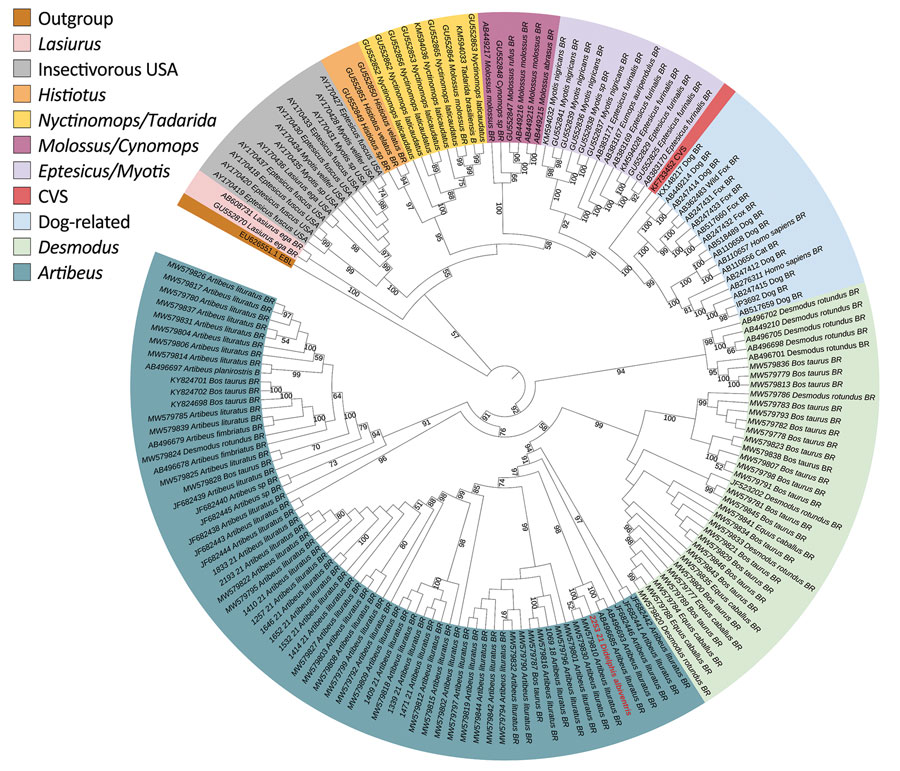Volume 29, Number 12—December 2023
Dispatch
Naturally Acquired Rabies in White-Eared Opossum, Brazil
Figure 1

Figure 1. Rabies virus G gene phylogenetic tree showing specific clusters for different genera of bats in Brazil and dog-related samples in study of naturally acquired rabies in a white-eared opossum, Brazil (red text). The phylogeny was reconstructed by maximum-likelihood estimation from nucleotide sequences. Bootstrap values of >50% are depicted (1,000 bootstrap replicates). CVS corresponds to a fixed strain of the rabies virus. European bat lyssavirus-1 was used as an outgroup. The tree was visualized using iTOL version 6 (6). GenBank accession numbers are provided for reference sequences.
References
- Scott TP, Nel LH. Lyssaviruses and the fatal encephalitic disease rabies. Front Immunol. 2021;12:
786953 . DOIPubMedGoogle Scholar - Diana NK, Mitchell KC, Feldman KA. Shedding light on rabies in opossums. J Am Vet Med Assoc. 2015;247:1229.PubMedGoogle Scholar
- Castilho JG, de Souza DN, Oliveira RN, Carnieli P Jr, Batista HBCR, Pereira PMC, et al. The epidemiological importance of bats in the transmission of rabies to dogs and cats in the state of São Paulo, Brazil, between 2005 and 2014. Zoonoses Public Health. 2017;64:423–30. DOIPubMedGoogle Scholar
- Brazilian Institute of Geography and Statistics (IBGE). Cities and states: Campinas Panorama [cited 2023 Jul 2]. https://cidades.ibge.gov.br/brasil/sp/campinas/panorama
- World Organization of Animal Health (WOAH). Chapter 3.1.18. Rabies (infection with rabies virus and other lyssaviruses). In: WOAH Terrestrial Manual 2023 [cited 2023 Mar 2]. https://www.woah.org/fileadmin/Home/eng/Health_standards/tahm/3.01.18_RABIES.pdf
- Letunic I, Bork P. Interactive Tree Of Life (iTOL) v5: an online tool for phylogenetic tree display and annotation. Nucleic Acids Res. 2021;49(W1):W293–6. DOIPubMedGoogle Scholar
- Beamer PD, Mohr CO, Barr TR. Resistance of the opossum to rabies virus. Am J Vet Res. 1960;21:507–10.PubMedGoogle Scholar
- Fornazari F, Scheffer KC, Dos Ramos Silva S, da Silva KR, Rodrigues AC, Teixeira CR, et al. Seroprevalence to rabies virus in wildlife in Brazil. J Wildl Dis. 2022;58:431–5. DOIPubMedGoogle Scholar
- Udow SJ, Marrie RA, Jackson AC. Clinical features of dog- and bat-acquired rabies in humans. Clin Infect Dis. 2013;57:689–96. DOIPubMedGoogle Scholar
- Gazarini J, Brito JE, Bernardi IP. Opportunistic predations of bats by Didelphis albiventris in southern Brazil [in Portuguese]. Chiroptera Neotropical. 2008;14:408–11.
- Dias RA, Rocha F, Ulloa-Stanojlovic FM, Nitsche A, Castagna C, de Lucca T, et al. Spatiotemporal distribution of a non-haematophagous bat community and rabies virus circulation: a proposal for urban rabies surveillance in Brazil. Epidemiol Infect. 2019;147:
e130 . DOIPubMedGoogle Scholar - Queiroz LH, Favoretto SR, Cunha EM, Campos AC, Lopes MC, de Carvalho C, et al. Rabies in southeast Brazil: a change in the epidemiological pattern. Arch Virol. 2012;157:93–105. DOIPubMedGoogle Scholar
- Caraballo DA, Lema C, Novaro L, Gury-Dohmen F, Russo S, Beltrán FJ, et al. A novel terrestrial rabies virus lineage occurring in South America: origin, diversification, and evidence of contact between wild and domestic cycles. Viruses. 2021;13:2484. DOIPubMedGoogle Scholar
- Ribeiro J, Staudacher C, Martins CM, Ullmann LS, Ferreira F, Araujo JP Jr, et al. Bat rabies surveillance and risk factors for rabies spillover in an urban area of Southern Brazil. BMC Vet Res. 2018;14:173. DOIPubMedGoogle Scholar
1These first authors contributed equally to this article.
2These senior authors contributed equally to this article.
3These authors were co–principal investigators.